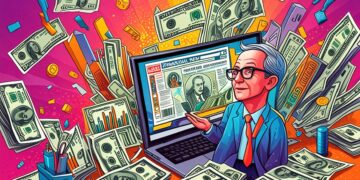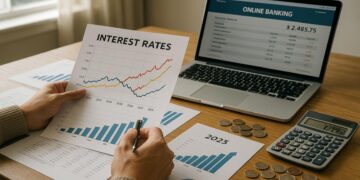Impact of Interest Rates on the American Economy: What the Latest News Reveals

Understanding the Ripple Effect of Interest Rates
Interest rates play a pivotal role in the economic ecosystem, influencing countless aspects of financial life in the United States. These seemingly simple percentages hold the power to impact everything from individual purchasing behavior to large-scale corporate investments. Recognizing how fluctuations can ripple through your financial landscape is essential for making informed decisions that can safeguard your future.
Borrowing Costs: When interest rates increase, the cost of borrowing rises significantly. For example, if you’re considering purchasing a home, an increase of just one percentage point in mortgage rates can add hundreds of dollars to your monthly payment, complicating your ability to afford that dream home. This scenario is not limited to mortgages; personal lending, car loans, and credit cards all become more expensive, restricting access to necessary funds. Imagine wanting to upgrade your vehicle or take out a personal loan for unexpected expenses only to find that the increased interest means paying much more in the long run. The burden of these higher costs can deter families from making essential investments, thereby stifling personal progress and ambition.
Consumer Spending: The relationship between interest rates and consumer psychology is profound. As rates rise, consumers often feel the pinch of tightened budgets. They may curtail spending on non-essential items, leading to decreased retail sales and a slowdown in overall economic activity. For instance, a family might choose to postpone a vacation or delay purchasing a new appliance, which can have a domino effect on businesses in those sectors. Retailers responding to reduced consumer spending may cut back on inventory or lay off employees, further impacting job availability and growth. This chain reaction ultimately embodies the concept of the ripple effect, demonstrating how one financial decision can yield far-reaching consequences.
Investment Decisions: For businesses, higher interest rates can mean more expensive borrowing costs, leading to hesitance in making significant investments. A company contemplating expanding its operations may delay or scale back its plans if the financing costs are perceived as too risky. For instance, a thriving tech startup might decide to put off launching a new product line, consequently stunting job creation and innovation. When businesses limit expansion, it not only affects their growth but also contributes to a stagnating economy, reducing overall competition and consumer choice in the market.
With recent fluctuations in interest rates, being mindful of these various effects is crucial. This awareness can empower you to take proactive steps in managing your finances wisely—such as budgeting for potential rate increases or exploring refinancing options before rates climb higher. Understanding the connection between interest rates and the economy encourages you to approach financial decisions with confidence and foresight.
As we navigate this complex landscape, arm yourself with knowledge, insights, and a proactive mindset. By doing so, you not only secure your financial future but can inspire those around you to embrace responsible financial practices as well. Each informed decision builds towards a more prosperous tomorrow for you, your family, and your community.
DISCOVER: Click here to learn valuable insights
The Interconnection of Interest Rates and Economic Growth
As we delve deeper into the dynamics of interest rates, it’s essential to recognize their influence on various spheres of the economy beyond just borrowing and spending. The decisions made by policymakers regarding interest rates have the capacity to spur growth or contraction, reflecting deeply on the overall health of the American economy. With the Federal Reserve often at the helm, each adjustment is a deliberate effort to achieve stability and foster sustainable economic growth.
Housing Market Dynamics: The housing market serves as a prime example of how interest rate changes can reshape economic landscapes. When interest rates increase, not only do mortgage payments escalate, but fewer individuals may qualify for loans, effectively cooling the housing market. A decrease in demand can lead to lower home prices, impacting homeowners’ equity and decreasing consumer confidence. Conversely, when the Fed lowers rates, borrowing becomes cheaper, often leading to a surge in home sales and construction projects. This cycle signifies the critical role interest rates play in fostering a thriving housing sector, which, in turn, affects employment in construction, real estate, and various supporting industries.
- Higher borrowing costs can lead to a stagnant housing market.
- Increased accessibility due to lower rates promotes home buying and construction.
- Consumer confidence is often tied to home equity and market performance.
Impact on Small Businesses: Small businesses, often referred to as the backbone of the American economy, are significantly affected by interest rate fluctuations. These businesses typically rely on loans to fund operations, expand their reach, or innovate their offerings. Higher interest rates can deter entrepreneurs from taking necessary risks, leading to reduced growth opportunities. A small business owner contemplating the launch of a new product line might think twice if financing options are burdened with high interest. This hesitation can stifle creativity and delay advancements, ultimately impacting job creation—a vital component of a healthy economy.
Inflation and Purchasing Power: Another critical consideration is how interest rates influence inflation and the purchasing power of consumers. When the Federal Reserve raises rates, it aims to curb inflation by discouraging borrowing and spending. While this is necessary for maintaining price stability, it can also lead to a decrease in consumer purchasing power. As costs rise and budgets tighten, families may prioritize essentials over luxuries, affecting businesses at every level. The ripple effect of decreased consumer demand can reduce a company’s profitability, leading to fewer job opportunities and an overall slowdown in economic growth.
In light of these factors, it is clear that understanding the intricate relationship between interest rates and the economy is vital. By appreciating how these rates affect various sectors, you can better navigate financial decisions during periods of change. Knowledge empowers you to adapt proactively, whether through refinancing mortgages at lower rates or adjusting your investment strategies in anticipation of economic shifts. As citizens of a dynamic economy, it is our responsibility to remain informed and engaged, fostering an environment where financial decision-making leads to collective prosperity.
DISCOVER MORE: Click here to learn about the symbolism of four in American culture
Shifts in Consumer Behavior and Spending
The intricate relationship between interest rates and consumer behavior is another key component of understanding their impact on the American economy. Interest rates not only dictate the dynamics of loans and credit but also shape how consumers approach their spending. When interest rates rise, consumers may feel the pinch in their wallets, leading to more cautious spending habits. Higher credit card interest rates, for instance, can dissuade individuals from making impulsive purchases, prompting them to reevaluate their financial priorities. Instead of splurging on non-essential items, families may choose to save, favoring financial security over immediate gratification.
Conversely, lower interest rates often encourage consumers to spend more freely. Lower rates translate to cheaper financing options for a range of purchases, from cars to appliances. This increased spending can ripple throughout the economy, boosting revenues for retailers and manufacturers alike. Additionally, many consumers view lower interest rates as a signal of economic stability, which can ignite their confidence and lead to higher expenditures. The result is a vibrant economic environment where money circulates, fostering job creation and growth across numerous sectors.
- Higher interest rates discourage consumer spending, pushing families to prioritize savings.
- Lower rates promote spending, as consumers feel empowered to make larger purchases.
- Consumer confidence plays a critical role in overall economic performance, closely tied to interest rate changes.
Investment Strategies and Market Responses
Interest rates also wield significant influence over investment strategies among individuals and institutions. When the Federal Reserve signals an increase in rates, investors often react by reallocating their portfolios—shifting from stocks to bonds or other fixed-income investments to secure more stable returns. The rationale is simple: rising interest rates typically lead to decreased bond prices and a more volatile stock market, prompting investors to tread carefully. The fear of market instability can lead to a slowdown in investments across sectors, subsequently dampening economic growth.
On the other hand, when rates are low, the environment may be ripe for riskier investments. Venture capitalists and angel investors may be more inclined to put money into startups, driving innovation and competition. This investment surge can foster technological advancements and creative solutions, propelling entire industries forward. Hence, understanding the shifts in interest rates can empower investors to make responsible decisions that align with broader economic trends, ensuring that they can adapt to the changing landscape.
- Interest rate increases prompt a reassessment of investment strategies, often leading to a shift toward safer assets.
- Low rates encourage risk-taking, facilitating innovation and growth in emerging sectors.
- Investor awareness is crucial for capitalizing on opportunities and understanding market dynamics.
Ultimately, the impact of interest rates on the American economy is multifaceted, influencing everything from everyday consumer choices to significant investment decisions. As citizens, being informed about these effects allows for more conscious financial planning, whether it involves adjusting savings strategies in light of borrowing costs or seizing the right investment opportunities during favorable economic conditions. Through this understanding, individuals can not only contribute to their financial well-being but also actively participate in the broader economic dialogue, fostering a resilient and prosperous nation.
DISCOVER MORE: Click here to dive deeper
Conclusion
The intricate dance between interest rates and the American economy cannot be overstated. As we have explored, interest rate changes directly affect consumer spending and investment strategies, highlighting the need for both individuals and businesses to stay informed about these shifts. Whether it’s families tightening their budgets during periods of rising rates or investors seizing opportunities in low-rate environments, the influence of interest rates reverberates through every level of our economic landscape.
In this dynamic context, both consumer confidence and investment choices become significant drivers of economic health. The decisions we make today—whether to spend, save, or invest—carry weight not only for personal finances but also for the collective well-being of our communities and the nation. As interest rates rise or fall, it is crucial for all stakeholders to remain vigilant, adjusting their approaches to align with economic realities. This adaptability can position us to thrive, fostering an environment that promotes innovation, stability, and growth.
Ultimately, understanding the impact of interest rates empowers us as citizens and investors, allowing us to create informed financial plans and contribute positively to the economic dialogue in our nation. As we navigate this ever-evolving landscape, let us prioritize conscious financial action, embracing opportunities to secure our financial futures while contributing to a resilient and prosperous American economy.






